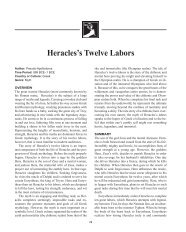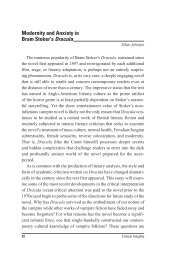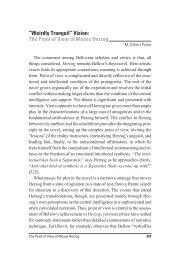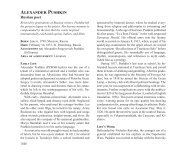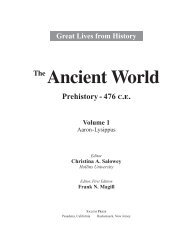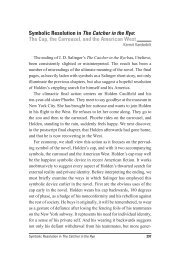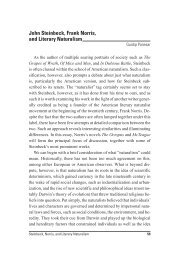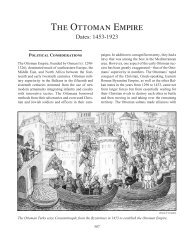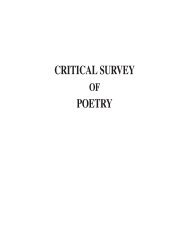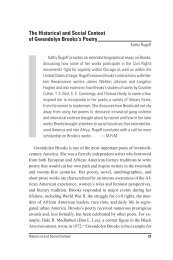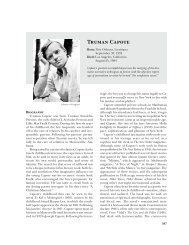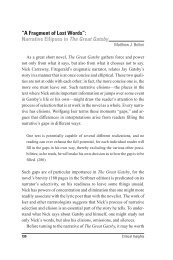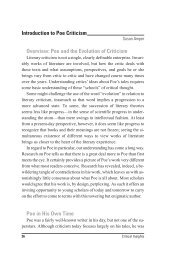Gabriel García Márquez: Cultural and Historical ... - Salem Press
Gabriel García Márquez: Cultural and Historical ... - Salem Press
Gabriel García Márquez: Cultural and Historical ... - Salem Press
You also want an ePaper? Increase the reach of your titles
YUMPU automatically turns print PDFs into web optimized ePapers that Google loves.
poration, the United Fruit Company, gave consent for the Colombian<br />
army to open fire on a workers’ demonstration, murdering hundreds of<br />
workers. From an early age, <strong>García</strong> <strong>Márquez</strong> was aware of the political<br />
history <strong>and</strong> violence in his country; Colombia, like most Latin American<br />
countries, possesses a complicated, exhausting history of civil<br />
wars, dictators, coups d’état, <strong>and</strong> social revolutions. Yet growing up in<br />
Aracataca was also magical. <strong>García</strong> <strong>Márquez</strong> felt close to his gr<strong>and</strong>father,<br />
a steadfast Liberal who fought in the Thous<strong>and</strong> Days’ War of<br />
1899-1902 <strong>and</strong> would be the subject of his novel No One Writes to the<br />
Colonel. His gr<strong>and</strong>mother also influenced him with her countless stories<br />
of ghosts <strong>and</strong> the dead. Between the violent war memories of his<br />
gr<strong>and</strong>father <strong>and</strong> the fabulous tales of his gr<strong>and</strong>mother, <strong>García</strong> <strong>Márquez</strong><br />
learned the art <strong>and</strong> power of storytelling at a young age.<br />
<strong>García</strong> <strong>Márquez</strong> attended the Universidad Nacional in Bogotá to<br />
study law, but he spent most of his time reading literature <strong>and</strong> writing<br />
stories. A significant influence on his decision to become a writer was<br />
his reading of Franz Kafka’s novella The Metamorphosis. InaParis<br />
Review interview, he told Peter Stone that the first line of the story, in<br />
which Gregor Samsa awakens as a cockroach, “almost knocked me off<br />
the bed I was so surprised. ...WhenIread the line I thought to myself<br />
that I didn’t know anyone was allowed to write things like that. If I had<br />
known, I would have started writing a long time ago” (319). He was<br />
also inspired by the modernists, particularly by Virginia Woolf’s use of<br />
interior monologue <strong>and</strong>, even more important, William Faulkner’s narrative<br />
techniques, themes, <strong>and</strong> small-town settings. <strong>García</strong> <strong>Márquez</strong>’s<br />
first novel, Leaf Storm, is his most Faulknerian in terms of plot pattern<br />
<strong>and</strong> style, echoing the narrative structures of As I Lay Dying <strong>and</strong> The<br />
Sound <strong>and</strong> the Fury. Macondo, the setting of his first four novels <strong>and</strong><br />
One Hundred Years of Solitude, is comparable to Faulkner’s mythical<br />
Yoknapatawpha County.<br />
<strong>García</strong> <strong>Márquez</strong> developed as a writer during one of the most violent<br />
periods in modern Colombian history. After he dropped out of college,<br />
he spent the 1950s writing for various newspapers <strong>and</strong> living in<br />
20 Critical Insights



